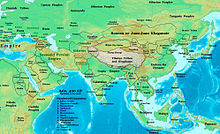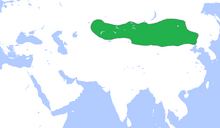Rouran Khaganate: Difference between revisions
→top: cleanup |
→top: wikilink |
||
| Line 7: | Line 7: | ||
|country = |
|country = |
||
|era = 1st millennium |
|era = 1st millennium |
||
|status = [[ |
|status = [[Khanate]] |
||
|year_start = 330 |
|year_start = 330 |
||
|year_end = 555 |
|year_end = 555 |
||
Revision as of 10:09, 6 July 2015
Rouran Khaganate | |||||||||||||
|---|---|---|---|---|---|---|---|---|---|---|---|---|---|
| 330–555 | |||||||||||||
 | |||||||||||||
| Status | Khanate | ||||||||||||
| Capital | Mumo city, Orkhon River, Mongolia | ||||||||||||
| Religion | Shamanism Buddhism | ||||||||||||
| Khagan | |||||||||||||
• 330 | Yùjiǔlǘ Mùgǔlǘ | ||||||||||||
• 555 | Yujiulü Dengshuzi | ||||||||||||
| Legislature | Kurultai | ||||||||||||
| Historical era | 1st millennium | ||||||||||||
• Established | 330 | ||||||||||||
• Disestablished | 555 | ||||||||||||
| Area | |||||||||||||
| 405[1][2] | 4,000,000 km2 (1,500,000 sq mi) | ||||||||||||
| |||||||||||||
| Today part of | |||||||||||||
Template:Alternative names Template:Alternative names
| History of Mongolia |
|---|
 |
The Rouran Khaganate Chinese: 柔然; pinyin: Róurán), also known as the Ruru (Chinese: 蠕蠕/茹茹; pinyin: Rúrú), or Tantan[3] (Chinese: 檀檀; pinyin: Tántán) was the name of a state of Eurasian nomads, presumably proto-Mongols, from the late 4th century until the middle 6th century.[4] It has sometimes been hypothesized that the Rouran are identical to the Pannonian Avars who later appeared in Europe.[5]
The term Rouran is a Classical Chinese transcription of the pronunciation of the name the confederacy used to refer to itself. Ruanruan and Ruru remained in usage despite being derogatory. They derived from orders given by the Emperor Taiwu of Northern Wei, who waged war against the Rouran and intended to intimidate the confederacy.
The power of the Rouran was broken in 552 by an alliance of Göktürks, the states of Northern Qi and Northern Zhou, and tribes in Central Asia.
Origin and expansion
The Rouran were a confederation led by Xianbei people who remained in the Mongolian steppes after most Xianbei migrated south to Northern China and set up various kingdoms. They considered that Tuoba and Rourans descended from common ancestors.[6] Also historian of the Northern Wei noted that Rourans descended from Xianbei. They were first noted as having defeated the Tiele and establishing an empire extending all the way to the Hulun, an alliance in eastern Inner Mongolia. During the reign of Yujiulü Shelun king (402-410) Rouran became powerful empire. To the west of the Rouran Khaganate was the Hephthalite Empire (408–670), which was a vassal of the Rouran until the beginning of the 5th century.[7][8]
Between Hephthalites and Rourans were also close contacts, although they had different languages and cultures, and Hephthalites borrowed much of their political organization from Rourans.[8] In particular, the title “Khan“, which according to McGovern was original to the Rourans, was borrowed by the Hephthalite rulers.[8] The reason for the migration of the Hephthalites southeast was to avoid a pressure of the Rourans. Further, the Hephthalites defeated the Yuezhi in Bactria and their leader Kidara led the Yuezhi to the south.[8]
The Rouran controlled the area of Mongolia from the Manchurian border to Turpan and, perhaps, the east coast of Lake Balkhash, and from the Orkhon River to China proper. Their ancestor Mugulu is said to have been originally a slave of the Tuoba tribes, situated at the north banks of Yellow River Bend. Mugulu's descendant Yujiulü Shelun is said to be the first chieftain who was able to unify the Rouran tribes and to found the power of the Rouran by defeating the Tiele and Xianbei. Shelun was also the first of the steppe peoples to adopt the title of khagan (可汗) in 402, originally a title of Xianbei nobility.
The Rouran Khaganate arranged for one of their princesses, Khagan Yujiulü Anagui's daughter Princess Ruru to be married to the Han Chinese ruler Gao Huan of the Eastern Wei.[9]
The Rouran and the Hephthalites had a falling out and problems within their confederation were encouraged by Chinese agents. In 508, the Tiele defeated the Rouran in battle. In 516, the Rouran defeated the Tiele. Within the Rouran confederation was a Turkic tribe noted in Chinese annals as the Göktürks (Chinese: 突厥). After a marriage proposal to the Rouran was rebuffed, the Göktürks joined the Western Wei, successor state of the Northern Wei, and revolted against the Rouran. In 555, they beheaded 3,000 Rouran. Some scholars claim that the Rouran then fled west across the steppes and became the Avars, though many other scholars contest this claim.[4] The remainder of the Rouran fled into China, were absorbed into the border guards, and disappeared forever as an entity. The last khagan fled to the court of the Western Wei, but at the demand of Tujue, Western Wei executed him and the nobles that accompanied him.



Little is known of the Rouran ruling elite, which the Book of Wei cited as an offshoot of the Xianbei. The Rouran subdued modern regions of Xinjiang, Mongolia, Central Asia, and parts of Siberia and Manchuria from the late 4th century. Their frequent interventions and invasions profoundly affected neighboring countries. Though they admitted the Ashina of Göktürks into their federation, the power of the Rouran was broken by an alliance of Göktürks, the states of Northern Qi and Northern Zhou, and Central Asian tribes in 552. The Northern Wei, for instance, established the Six Garrisons bordering the Rouran, which later became the foci of several major mutinies in the early 6th century.
Khaghans of the Rouran
The Rourans were the first people who used the titles Khagan and Khan for their emperors (which are, therefore, assumed to be proto-Mongols), replacing the Chanyu of the Xiongnu, whom Grousset and others assume to be Turkic.[10]
- Yujiulü Mugulü, 4th century
- Yujiulü Cheluhui, 4th century
- Yujiulü Tunugui, 4th century
- Yujiulü Bati, 4th century
- Yujiulü Disuyuan, 4th century
- Yujiulü Pihouba, 4th century
- Venheti, 4th century
- Yujiulü Mangeti, 4th century
- Yujiulü Heduohan, 4th century
- Yujiulü Shelun, 402–410
- Yujiulü Hulü, 410–414
- Yujiulü Datan, 414–429
- Yujiulü Wuti, 429–444
- Yujiulü Tuhezhen, 444–450
- Yujiulü Yucheng, 450–485
- Yujiulü Doulun, 485–492
- Yujiulü Nagai, 492–506
- Yujiulü Futu, 506–508
- Yujiulü Chounu, 508–520
- Yujiulü Anagui, 520–552
- Yujiulü Poluomen, 521–524
- Yujiulü Tiefa, 552–553
- Yujiulü Dengzhu, 553
- Yujiulü Kangti, 553
- Yujiulü Anluochen, 553–554
- Yujiulü Dengshuzi, 555
References
- ^ Rein Taagepera "Size and Duration of Empires: Growth-Decline Curves, 600 B.C. to 600 A.D.", Social Science History Vol. 3, 115-138 (1979)
- ^ Jonathan M. Adams, Thomas D. Hall and Peter Turchin (2006). East-West Orientation of Historical Empires.Journal of World-Systems Research (University of Connecticut). 12 (no. 2): 219–229.
- ^ Zhang, Min. Lun Beiwei Changcheng Junzheng Fangwei Tixi De Jianli ("On the Defensive System of Great Wall Military Town of Northern Wei Dynasty") China’s Borderland History and Geography Studies, Jun. 2003 Vol. 13 No. 2. Page 15.
- ^ a b West, Barbara A. (2008). Encyclopedia of the Peoples of Asia and Oceania. Infobase Publishing. p. 687. ISBN 978-0-8160-7109-8. Retrieved 26 May 2011.
- ^ Findley (2005), p. 35.
- ^ Hyacinth (Bichurin), Collection of information on peoples lived in Central Asia in ancient times, 1950. p.209
- ^ Grousset (1970), p. 67.
- ^ a b c d Kurbanov, A. The Hephthalites: Archaeological and historical analysis. PhD dissertation, Free University, Berlin, 2010
- ^ Lee, Lily Xiao Hong; Stefanowska, A. D. Biographical Dictionary of Chinese Women: Antiquity Through Sui, 1600 B.C.E.-618 C.E. M.E. Sharpe. ISBN 978-0-7656-4182-3.
{{cite book}}: Invalid|ref=harv(help) p. 316. - ^ Grousset (1970), pp. 61, 585, n. 91.
Sources
- Findley, Carter Vaughn. (2005). The Turks in World History. Oxford University Press. ISBN 0-19-516770-8 (cloth); ISBN 0-19-517726-6 (pbk).
- Grousset, René. (1970). The Empire of the Steppes: a History of Central Asia. Translated by Naomi Walford. Rutgers University Press. New Brunswick, New Jersey, U.S.A.Third Paperback printing, 1991. ISBN 0-8135-0627-1 (casebound); ISBN 0-8135-1304-9 (pbk).
- Map of their empire
- Definition
- information about the Rouran
- Kradin, Nikolay. "From Tribal Confederation to Empire: the Evolution of the Rouran Society". Acta Orientalia Academiae Scientiarum Hungaricae, Vol. 58, No 2 (2005): 149-169.
